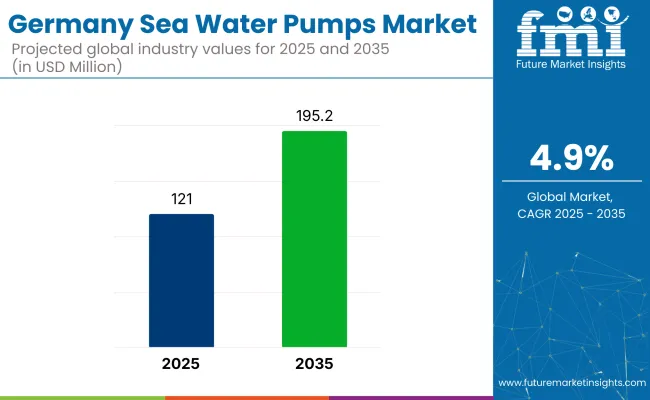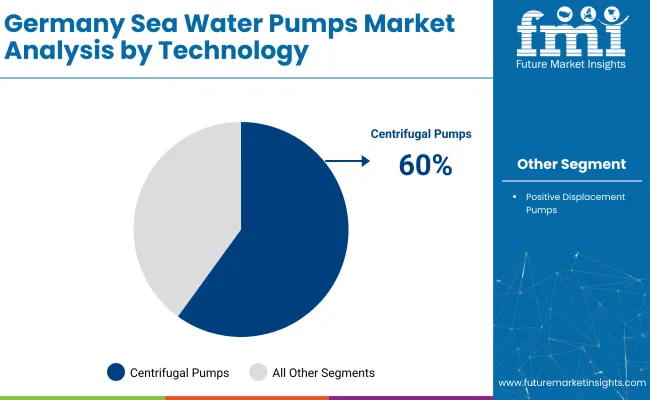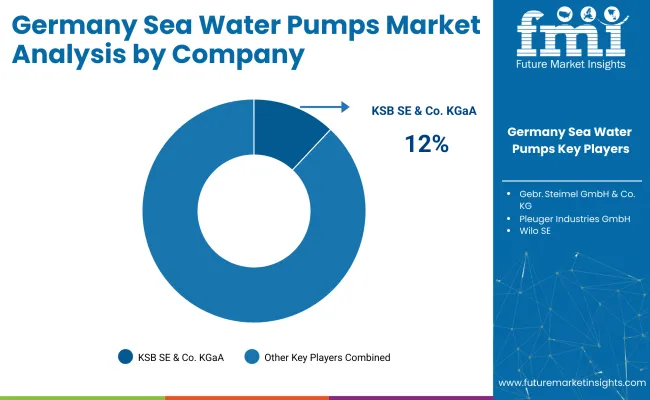The Germany sea water pumps market is expected to witness consistent expansion, with its value anticipated to rise from USD 121 Million in 2025 to USD 195.2 Million by 2035, progressing at a steady CAGR of 4.9% during the forecast period. The demand for advanced seawater pump systems is being driven by the need to support marine and industrial applications.
Market development is being driven by the increasing requirement for corrosion-resistant and energy-efficient pump solutions suitable for harsh saline environments, such as shipbuilding, offshore platforms, and desalination units.

Among product types, centrifugal pumps are projected to maintain dominance with nearly 60% market share in 2025, favored for their operational efficiency and adaptability across various marine and industrial processes.
In the end-use segment, marine applications are expected to remain the largest category, holding approximately 45% share in 2025, as robust shipbuilding activities, naval modernization programs, and maintenance operations across German ports are being undertaken.
This was confirmed by a Johnson Controls press release published on October 24, 2024, which announced that the SABROE DualPAC CO₂-based seawater heat pump was provided to the municipal utility of Neustadt in Holstein. Baltic Sea water is being utilized by the system to supply green district heating for a new harbor-area development, marking Germany’s first project of this kind.
The innovative use of seawater pumps for sustainable energy applications was highlighted by this initiative, setting a precedent for future projects aimed at reducing carbon emissions and improving energy efficiency in marine and coastal infrastructure.
Furthermore, smart control systems and predictive maintenance technologies are being integrated into seawater pumps by German manufacturers to enhance reliability and reduce operational costs. These efforts are being aligned with the country’s objectives related to industrial digitization and environmental sustainability.
Centrifugal pump technology and marine applications are set to lead Germany’s sea water pumps market in 2025, driven by operational efficiency, high flow handling, and widespread use in shipbuilding and offshore sectors.

Centrifugal pumps are projected to dominate the technology segment with a 60% market share in 2025, owing to their superior flow handling, energy efficiency, and reliability in seawater transfer operations.
These pumps are widely used in marine and industrial systems where large volumes of seawater need to be moved with minimal maintenance. Their simple design ensures low operating costs and ease of service, making them preferable over positive displacement or jet pumps. Advanced material coatings and corrosion-resistant designs further enhance their performance in saline environments.
Industries such as shipbuilding, offshore oil platforms, and desalination plants heavily rely on centrifugal pump technology for uninterrupted operations.

Marine applications are anticipated to lead the end-use segment with a 45% market share in 2025, supported by Germany’s robust shipbuilding, naval, and offshore energy sectors. Seawater pumps are essential in various marine operations, including cooling, ballast transfer, firefighting, and desalination onboard vessels.
The growing demand for commercial cargo ships, naval fleets, and offshore platforms drives continuous investments in reliable pump systems. Industrial applications such as seawater desalination and chemical processing also contribute but at a smaller scale.
Marine end-users prioritize corrosion-resistant, high-capacity pumps to ensure operational safety and efficiency in harsh saline environments, reinforcing this segment's dominance in the market.
Marine sector demand and environmental regulations are steering Germany’s sea water pumps market. Marine-grade centrifugal units and corrosion-resistant desalination pumps are gaining traction amid industrial and ecological priorities.
Dominance of Marine and Shipbuilding Applications
Germany’s strong shipbuilding and offshore industries are driving demand for specialized sea water pumps. Marine applications, including ballast water systems and firefighting pumps, account for a significant market share.
German manufacturers such as KSB and Wilo supply corrosion-resistant centrifugal units tailored to naval specifications. Naval operators are requesting pumps that meet shock-resistance and maritime safety standards. Desmi has been adapting pumps for military ships, ensuring compliance with stringent requirements.
These vessels must handle saltwater exposure reliably. Demand is being propelled by ongoing fleet modernization, offshore platform maintenance, and export-led marine equipment production. This concentration on marine use places Germany at the forefront of seawater pump innovation and production.
Stringent Environmental Policies Fueling Industrial and Desalination Pump Adoption
Industrial cooling and desalination processes in Germany are being shaped by strict environmental regulations and water scarcity concerns. Power plants and chemical facilities rely on sea water pumps for thermal regulation and process water intake. Germany’s investment in desalination projects and technologies like reverse-osmosis has increased demand for durable, corrosion-resistant seawater pumps. Companies like Andritz and DESMI are supplying duplex-steel centrifugal units designed to meet regulatory standards and withstand harsh saline environments.
Pump selection is being driven by energy efficiency metrics and environmental compliance mandates. This emphasis on eco-friendly, high-performance water management equipment is promoting technological enhancements in material, design, and pump reliability.
The Germany sea water pumps market presents regional disparities shaped by each state's industrial strength, port activities, and marine infrastructure.
Manufacturers and stakeholders can leverage these differences to tap into localized growth opportunities. Below is an in-depth analysis of five key German states driving demand for sea water pumps.
| States | CAGR (2025-2035) |
|---|---|
| Schleswig-Holstein | 4.0% |
| Hamburg | 3.8% |
| Bremen | 3.6% |
| Lower Saxony (Niedersachsen) | 4.1% |
| Mecklenburg-Vorpommern | 3.5% |
A steady expansion in the sea water pumps market of Schleswig-Holstein is projected, with a CAGR of 4.0% anticipated between 2025 and 2035. Demand is being fueled by the state’s strategic location along the North Sea and Baltic Sea. Offshore wind farms and modernization projects at ports in Kiel and Lübeck are being actively developed, enhancing market prospects.
Energy-efficient and corrosion-resistant sea water pumps are being increasingly adopted to support these marine initiatives. Sustainability goals and marine conservation policies are also being emphasized by authorities, encouraging the deployment of advanced pump technologies capable of operating efficiently under demanding offshore environmental conditions.
Steady growth in the sea water pumps market of Hamburg is expected, with a CAGR of 3.8% projected through 2035. Continuous upgrades at the Port of Hamburg are being implemented, strengthening its shipbuilding and repair capabilities. High-performance pump systems are being demanded to serve the expanding fleet of container vessels, cruise liners, and specialty ships operating from the port.
Corrosion-resistant and compact pump models are being developed by manufacturers to fulfill these needs. Additionally, digitalized port operations are being introduced, thereby creating a requirement for smart, automated pump technologies designed to enhance operational efficiency and safety within maritime activities.
A consistent rise in the sea water pumps market of Bremen is anticipated, with a CAGR of 3.6% forecasted for the 2025–2035 period. Maritime logistics and shipbuilding activities are being expanded, especially around Bremerhaven’s port infrastructure.
Demand for durable and low-maintenance sea water pumps is being driven by retrofitting and maintenance requirements of naval and commercial vessels. Locally produced pumps are being engineered to ensure minimal downtime and extended service life to meet operational demands. Modernization of marine facilities and adherence to efficiency standards are being prioritized by stakeholders, supporting the deployment of advanced pump technologies across various maritime sectors.
Rapid expansion of the sea water pumps market in Lower Saxony is being projected, with a leading CAGR of 4.1% anticipated during the forecast period. Offshore wind farms in the North Sea and port expansions in cities such as Wilhelmshaven are being advanced, fostering increased pump demand.
High-capacity, corrosion-proof pumps integrated with remote monitoring features are being deployed to ensure efficiency in challenging marine environments. Both renewable energy and shipping sectors are being served by these advanced solutions. Investments in robust pump technologies are being prioritized by manufacturers to meet the specific requirements of offshore and heavy-duty maritime operations.
Gradual growth in the sea water pumps marketin Mecklenburg-Vorpommern is expected, with a CAGR of 3.5% forecasted from 2025 to 2035. Development of coastal tourism and harbor facilities along the Baltic Sea is being promoted, resulting in demand for compact, cost-effective pump systems.
Energy-efficient sea water pumps designed for desalination and wastewater treatment applications are being introduced to support sustainability goals. Efforts to preserve marine ecosystems are being implemented by authorities, further encouraging the use of environmentally friendly pumping technologies.
As tourism infrastructure expands, the reliance on durable and reliable sea water pumps is being strengthened across coastal hospitality services.

The Germany sea water pumps market is characterized by a moderately consolidated landscape, in which suppliers are classified into Tier 1, Tier 2, and Tier 3 categories.
Technological innovation, extensive global service networks, and strong brand equity are demonstrated by Tier 1 companies such as KSB SE & Co. KGaA and Wilo SE, by whom the market is largely dominated. Specialized solutions, including submersible pumps for offshore platforms and desalination plants, are provided by Tier 2 firms such as Pleuger Industries GmbH.
Niche segments are served by Tier 3 companies like Gebr. Steimel GmbH & Co. KG, through the offering of customized, corrosion-resistant pump systems tailored for small-scale shipbuilding and coastal infrastructure projects in Germany.
Recent Germany Sea Water Pumps Market News
On October 24, 2024, Germany’s first large-scale CO₂-based seawater heat pump, the SABROE DualPAC, was successfully commissioned by Johnson Controls for the municipal utility of Neustadt in Holstein. Baltic Sea water is being utilized by this advanced system to provide sustainable district heating, and a significant milestone in Germany’s renewable energy sector was marked by this development.
The country’s commitment to eco-friendly technologies aimed at reducing carbon emissions and enhancing energy efficiency in urban heating solutions is reflected in this installation, which has been aligned with Germany’s broader climate-neutral energy transition goals.
| Report Attributes | Details |
|---|---|
| Market Size (2025) | USD 121.0 million |
| Projected Market Size (2035) | USD 195.2 million |
| CAGR (2025 to 2035) | 4.9% |
| Base Year for Estimation | 2024 |
| Historical Period | 2020 to 2024 |
| Projections Period | 2025 to 2035 |
| Quantitative Units | USD million for value and thousand units for volume |
| Technologies Analyzed (Segment 1) | Centrifugal Pumps, Positive Displacement Pumps |
| End Uses Analyzed (Segment 2) | Marine Applications, Industrial Processes, Desalination |
| Country Covered | Germany |
| States Covered | Baden-Württemberg, Bavaria, Berlin, Brandenburg, Bremen, Hamburg, Hesse, Lower Saxony, Mecklenburg-Vorpommern, North Rhine-Westphalia, Rhineland-Palatinate, Saarland, Saxony, Saxony-Anhalt, Schleswig-Holstein, Thuringia |
| Key Players influencing the Germany Sea Water Pumps Market | Gebr . Steimel GmbH & Co. KG, Pleuger Industries GmbH, KSB SE & Co. KGaA , Wilo SE |
| Additional Attributes | Dollar sales, share by technology and end-use, rising demand for seawater desalination systems, modernization of industrial seawater pump stations, technological advancements in energy-efficient pump systems |
The Germany sea water pumps market is segmented by technology into centrifugal pumps and positive displacement pumps.
By end use, the market is classified into marine applications, industrial processes, and desalination.
The Germany Sea Water Pumps Market is valued at USD 121.0 million in 2025.
The market is forecast to reach USD 195.2 million by 2035, growing at a CAGR of 4.9% during 2025-2035.
Centrifugal Pumps lead the market with approximately 60% share in 2025.
The Schleswig-Holstein region is projected to grow at a CAGR of 4.0% between 2025 and 2035.
Rising marine industrial applications and offshore energy projects are driving the market towards USD 195.2 million by 2035.






Full Research Suite comprises of:
Market outlook & trends analysis
Interviews & case studies
Strategic recommendations
Vendor profiles & capabilities analysis
5-year forecasts
8 regions and 60+ country-level data splits
Market segment data splits
12 months of continuous data updates
DELIVERED AS:
PDF EXCEL ONLINE
Germany Culinary Tourism Market Size and Share Forecast Outlook 2025 to 2035
Germany Casino Tourism Market Size and Share Forecast Outlook 2025 to 2035
Germany Automotive Turbocharger Market Growth – Trends, Demand & Innovations 2025–2035
Germany Yeast Market Outlook – Share, Growth & Forecast 2025–2035
Germany Green and Bio-based Polyol Market Report – Trends, Demand & Industry Forecast 2025–2035
Germany Natural Food Color Market Growth – Trends, Demand & Innovations 2025–2035
Germany Coated Fabrics Market Report – Trends, Demand & Industry Forecast 2025–2035
Germany Barite Market Report – Trends, Demand & Industry Forecast 2025–2035
Germany Compact Construction Equipment Market Outlook – Share, Growth & Forecast 2025–2035
Germany Flare Gas Recovery System Market Trends – Growth, Demand & Forecast 2025–2035
Germany Electric Golf Cart Market Insights – Trends, Demand & Growth 2025–2035
Germany Active Spoiler Market Analysis – Share, Growth & Forecast 2025-2035
Germany Magnetic Separator Market Outlook – Growth, Trends & Forecast 2025-2035
Germany 1,4-Diisopropylbenzene Market Analysis – Demand, Growth & Forecast 2025-2035
Germany Travel Agency Services Market Insights – Trends, Demand & Growth 2025-2035
Germany Sports Tourism Market Trends – Size, Demand & Forecast 2025-2035
Germany Power Tools Market Growth – Trends, Demand & Forecast 2025-2035
Germany Mountain and Ski Resort Market Analysis – Size, Trends & Growth 2025-2035
Germany Outbound Travel Market Report – Size, Trends & Innovations 2025-2035
Germany Medical Tourism Market Insights – Size, Trends & Forecast 2025-2035

Thank you!
You will receive an email from our Business Development Manager. Please be sure to check your SPAM/JUNK folder too.
Chat With
MaRIA